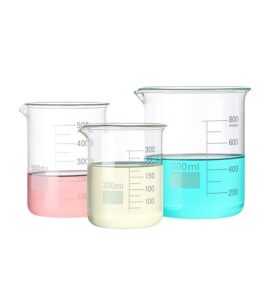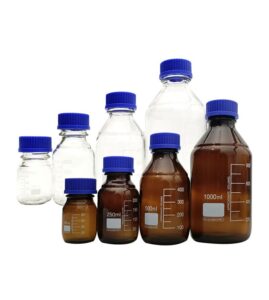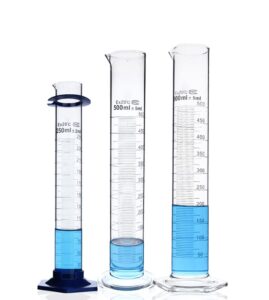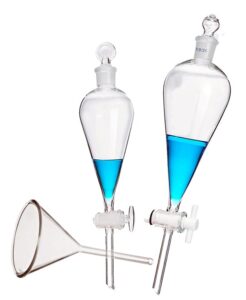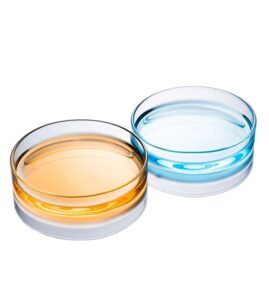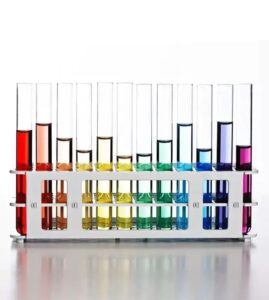Have you ever wondered what makes lab glassware withstand extreme conditions without shattering? Or why some glassware breaks at the slightest temperature change? In laboratories across the globe, glassware is the backbone of scientific research, providing the means to conduct experiments with precision and safety. But not all glass is created equal. The composition and manufacturing process of glass determine its resilience, especially when exposed to heat. So, what sets heat-resistant glass apart from ordinary glass materials?
The core difference lies in the materials used and the manufacturing process. Heat-resistant or borosilicate glass, renowned for its durability and thermal shock resistance, is a superhero in the world of glass. It contrasts significantly with soda-lime glass, the most common type of glass, which, while economical and widely used, lacks the same resilience against temperature fluctuations. Understanding these differences is not just academic; it has practical implications for the safety and effectiveness of scientific research.
What Makes Glass Heat-Resistant?
The secret to heat-resistant glass lies in its unique chemical composition. Borosilicate glass is made by adding boron to the glass mixture. This addition alters the glass’s physical properties, significantly increasing its resistance to thermal shock. Thermal shock occurs when glass is subject to rapid temperature changes, leading to stress that can cause it to crack or shatter. By incorporating boron, borosilicate glass can withstand temperature changes that would break ordinary glass.
Furthermore, the manufacturing process of borosilicate glass involves controlled cooling and heat treatment, which enhances its strength. This process, known as annealing, reduces internal stresses, making the glass more durable and less prone to breaking under pressure or when exposed to heat.
How Does Ordinary Glass Compare?
In contrast, ordinary glass, primarily soda-lime glass, is made from silica, soda (sodium carbonate), and lime (calcium oxide). This composition makes it cheaper to produce and suitable for everyday items like windows, bottles, and some types of tableware. However, soda-lime glass lacks the boron that gives borosilicate glass its heat resistance and strength. As a result, it is more prone to thermal shock and cannot withstand the same range of temperatures.
The annealing process for soda-lime glass is also less rigorous compared to borosilicate glass, which further limits its ability to handle sudden temperature changes. This is why using ordinary glassware for high-heat applications, such as cooking or laboratory experiments involving heat, is not advisable.
The Distinctive Qualities of Heat-Resistant Glass Versus Ordinary Glass
In the realm of scientific research and culinary applications, the choice between heat-resistant glass and ordinary glass is pivotal. This decision hinges on the material composition, thermal properties, and chemical stability that define each type of glass. Heat-resistant glass stands apart due to its specialized composition and enhanced capabilities, making it a superior choice for environments subject to high temperatures and chemical exposure.
Material Composition and Enhancements
Heat-resistant glass is crafted using a foundation of boron oxide and aluminum oxide, among other elements or oxides, to bolster its heat tolerance and chemical stability. This contrasts sharply with ordinary glass, which is predominantly composed of silica and sodium oxide. The inclusion of boron, in particular, allows heat-resistant glass to endure extreme thermal environments, a feature absent in its ordinary counterpart.
Superior Thermal Performance
One of the hallmark differences between heat-resistant and ordinary glass is their performance under heat. Heat-resistant glass is engineered to withstand temperatures typically upwards of 600°C (1112°F) without succumbing to thermal shock. This capability is crucial for applications requiring sustained exposure to high temperatures. Ordinary glass, however, is prone to thermal cracking, especially when subjected to rapid temperature changes, limiting its use in high-heat environments.
Chemical Stability
The chemical resilience of heat-resistant glass further distinguishes it from ordinary glass. Its composition renders it resistant to a wide array of acidic and alkaline solutions, making it less susceptible to corrosion. This property is invaluable in laboratory settings where glassware is frequently exposed to aggressive chemicals. In contrast, ordinary glass is more likely to deteriorate when in contact with strong acids or bases.
Transparency and Cost Implications
While both types of glass offer comparable levels of transparency, the manufacturing process for heat-resistant glass demands a higher level of technical expertise and cost investment. This results in a premium price point for heat-resistant glassware, reflecting its superior performance and durability.
Durability and Longevity
Heat-resistant glass, with its enhanced durability, tends to have a longer lifespan in the lab compared to ordinary glass. Its ability to withstand repeated thermal cycling without degradation makes it a cost-effective option for labs that prioritize long-term investment in quality equipment. Ordinary glass, while initially cheaper, may need to be replaced more frequently due to its susceptibility to thermal stress and chemical wear.
Safety Considerations
Safety is paramount in a laboratory environment, and the choice of glassware material plays a significant role in minimizing risk. Heat-resistant glass’s superior tolerance to sudden temperature changes reduces the risk of breakage, which can lead to accidents and contamination of experiments. In contrast, the fragile nature of ordinary glass under thermal shock conditions poses a higher risk, requiring more cautious handling and potentially leading to increased incidents in the lab.
Precision in Experimentation
The stability of heat-resistant glass under varying temperatures also contributes to its precision and reliability in experimental results. For experiments requiring precise temperature control or those involving exothermic reactions that generate heat, heat-resistant glass ensures that measurements and outcomes are not compromised by material limitations. Ordinary glass’s propensity to expand more under heat can introduce variability and potential errors in experimental data.
Adaptability to Specialized Equipment
Many advanced laboratory procedures require glassware that can be integrated with specialized equipment, such as autoclaves, hot plates, and distillation setups. Heat-resistant glass is more adaptable to these applications due to its ability to endure the associated stresses. Its compatibility with a broader range of laboratory techniques and equipment enhances its utility in complex experimental setups, whereas ordinary glass may not be suitable for use with equipment that subjects the glassware to extreme conditions.
Environmental and Health Impact
Finally, the manufacturing and disposal impacts of these glass types are worth considering. Heat-resistant glass, due to its durability and longer life cycle, may offer a more sustainable option with a lower environmental footprint over time. Additionally, its resistance to chemical leaching supports a safer laboratory environment, reducing the risk of exposure to harmful substances.
The differences between heat-resistant and ordinary glass in laboratory applications are profound, influencing not just the immediate cost and functionality of lab equipment but also safety, accuracy, and environmental impact. Understanding these distinctions is crucial for laboratory professionals who make decisions about the procurement and use of glassware, ensuring that their selections align with the specific needs and standards of their work.
Applications and Safety Considerations
Knowing the difference between heat-resistant and ordinary glass is crucial for choosing the right glassware for specific tasks. Borosilicate glassware is the preferred choice in laboratories for its durability and resistance to chemical corrosion, making it ideal for experiments involving high temperatures and harsh chemicals.
However, while borosilicate glass is more resistant to thermal shock, it is not indestructible. Sudden extreme changes in temperature can still cause it to break. Therefore, handling all types of glassware with care, following proper safety protocols, and understanding the limitations of the materials you are working with are essential.
Optimal Selection and Utilization of Ordinary and Heat-Resistant Glass in Laboratory Experiments
In the intricate world of chemical experiments, the selection of glassware is not just a matter of preference but a strategic decision that impacts the outcome and safety of experiments. Both ordinary and heat-resistant glass have their place in the lab, each catering to specific requirements based on their properties and tolerance to temperature variations. Understanding how to choose and use these materials correctly is essential for any laboratory operation.
Making the Right Choice
The cornerstone of effective laboratory practice is selecting the appropriate glassware for the task at hand. For high-temperature reactions or heating processes, heat-resistant glass is indispensable. Its ability to withstand significant thermal stress without compromising integrity makes it the go-to option for such applications. On the other hand, ordinary glass suffices for routine tasks such as mixing reagents or storing solutions where extreme temperatures are not a concern.
Prioritizing Safety
Safety is paramount in any laboratory setting. Special attention must be given to the handling and use of glassware, particularly when subjected to temperature changes. A gradual approach to heating and cooling is advised to mitigate the risk of thermal shock and potential breakage. Moreover, using protective gear and following established safety protocols can further reduce the likelihood of accidents.
Inspection and Maintenance
Before use, a thorough inspection of the glassware for any signs of damage, such as cracks or scratches, is crucial. Damaged glassware poses a significant risk and should be removed from service. Post-experiment, prompt and proper cleaning ensures the longevity and readiness of the glassware for future use. Regular maintenance also prevents corrosion and wear, preserving the glassware’s integrity.
Temperature Management
When conducting heated reactions, controlling the rate of temperature increase and the duration of heating is vital. This precaution prevents exceeding the glassware’s thermal tolerance, especially important for heat-resistant varieties. Despite their higher resistance to temperature changes, heat-resistant glassware should still be used within operational guidelines to ensure safety and prevent damage.
Additional Considerations
Beyond the basic guidelines, several nuances should be considered for optimal use of laboratory glassware:
- Compatibility with Chemicals: Certain experiments may involve corrosive chemicals that require the chemical inertness of heat-resistant glass.
- Cost-Benefit Analysis: While heat-resistant glass may come at a higher upfront cost, its durability and versatility can offer cost savings over time through reduced replacement needs.
- Environmental Factors: Laboratories aiming for sustainable practices might prefer glassware that aligns with eco-friendly operations, including considerations for energy consumption during glass production and recycling capabilities.
Correctly selecting and utilizing ordinary and heat-resistant glass in laboratory experiments is a nuanced process that significantly affects the safety, accuracy, and efficiency of scientific work. By understanding the specific properties and applications of each type of glass, laboratory personnel can make informed choices that enhance experimental outcomes and ensure the longevity of their glassware. Following these guidelines not only aids in conducting successful experiments but also fosters a culture of safety and responsibility within the laboratory environment.
The Role of Coefficient of Expansion
A key property that differentiates heat-resistant glass from ordinary glass is the coefficient of thermal expansion (CTE). This measure indicates how much a material expands when heated and contracts when cooled. Borosilicate glass boasts a lower CTE compared to soda-lime glass, meaning it expands and contracts less with temperature changes. This reduced expansion and contraction make borosilicate glass less likely to experience stress fractures under thermal shock.
This property is particularly crucial in lab settings where precision and reliability are paramount. For example, in the development of pharmaceuticals, even minute changes in the volume of glassware due to temperature shifts can lead to significant errors in experimental results. The low CTE of borosilicate glass ensures that measurements remain consistent and reliable, regardless of thermal fluctuations.
Environmental and Health Considerations
Another aspect worth considering is the environmental and health impact of different types of glass. Borosilicate glass, with its durable nature and resistance to chemical attack, often has a longer lifespan than soda-lime glass. This longevity can lead to reduced waste, as glassware does not need to be replaced as frequently. Additionally, the resistance to chemical leaching ensures that borosilicate glassware does not introduce contaminants into the environment or pose a risk to health during its use in labs.
Conversely, while soda-lime glass is more prevalent and recycled at a higher rate due to its widespread use in bottles and jars, its susceptibility to degradation and chemical leaching can pose environmental and health risks if not properly managed. The recycling process for soda-lime glass must be carefully controlled to prevent contamination of recycled products.
The Future of Lab Glassware
As scientific research advances, the demand for specialized glassware grows. Innovations in glass technology are leading to the development of even more resilient materials, such as aluminosilicate glass, which offers superior strength and thermal resistance compared to traditional borosilicate glass. These advancements promise to further enhance the safety and efficiency of laboratory work, paving the way for groundbreaking discoveries.
Moreover, the push for sustainability is driving research into eco-friendly manufacturing processes and recycling methods for lab glassware. These initiatives aim to minimize the environmental impact of scientific research without compromising the quality and integrity of experiments.
Navigating the World of Lab Glassware
Choosing the right type of glassware for a specific laboratory application is more than a matter of preference; it’s a decision that impacts the accuracy of research outcomes, safety, and environmental sustainability. As such, scientists and lab technicians must be well-informed about the properties of different glass materials and their appropriate uses.
When selecting lab glassware, consider not only the thermal and chemical resistance needed for your experiments but also the broader implications of your choice on health and the environment. By doing so, you contribute to advancing scientific research responsibly and sustainably.
Conclusion
Whether you’re a seasoned scientist or a curious learner, embracing the right type of lab glassware is pivotal for the integrity of your experiments. As we navigate the evolving landscape of scientific research, let’s commit to informed decision-making, ensuring our endeavors not only advance knowledge but do so with the utmost safety and responsibility. Join us in exploring the wonders of science, equipped with the best tools the field has to offer.


